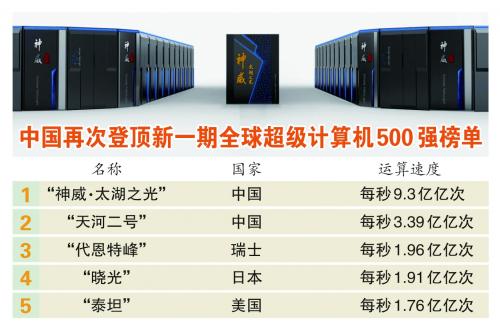
Reporter Liu Yang, Special Correspondent
“China has now surpassed the United States to become the country with the most supercomputers on the TOP500 list,†reported the BBC on the 14th. A new edition of the global supercomputer ranking was released, and China’s “Shenwei Taihu Lake†and “Tianhe II†have once again claimed the top spots for the fourth consecutive time. In total, China now has 202 high-performance computers in the world, compared to the U.S. which has only 143. This is the lowest number the U.S. has ever recorded since the list began 25 years ago, but it still holds second place. Many international media outlets are reporting that the era of Chinese supercomputing has arrived. But is this really true? What does the future hold for the Sino-U.S. competition in supercomputing? To explore these questions, Global Times reporter spoke with Zhang Yunquan, an expert in China’s supercomputing field.
China Dominates the Top 5
The top five supercomputers in the list come from four different countries. China’s “Shenwei Taihu Lake†took first place with a speed of 9.3 petaflops per second (93P). The second and third places were taken by China’s “Tianhe II†and Switzerland’s “Daint.†The U.S.’s “Titan,†which previously ranked fourth, was overtaken by Japan’s “Fugaku†and fell to fifth. According to the TOP500 list, besides China and the U.S., Japan ranks third with 35 systems, followed by Germany with 20. Additionally, China now accounts for 35.4% of the total computing power, surpassing the U.S.’s 29.6%.
Zhang Yunquan, secretary-general of the High Performance Computing Committee of the China Computer Society and director of the National Supercomputing Jinan Center, told the Global Times that the continued dominance of Chinese systems was expected. He believes that China could reclaim the top spot next year.
However, the Global Times found that although “Tianhe II†reclaimed the second position, its performance hasn’t changed since last time, suggesting that the planned upgrade may not have been completed yet. Previously, “Tianhe II†was expected to reach around 90P.
Has China’s Supercomputing Era Truly Arrived?
According to the German Voice of Germany, at a time when the U.S. dominated the global supercomputer rankings, this is now history. China has climbed to the top and now leads in the total number of supercomputers. Just four months ago, the U.S. had 169 systems, ahead of China’s 160. This shift reflects increased investment in R&D in China, where R&D spending now accounts for 20% of the global total, according to recent research.
Eric Stromile, co-founder of the TOP500 list, told the BBC that many Chinese supercomputers are designed for commercial use. Owners rent out their processing power to local and international companies. He also noted that other countries’ pursuit of high rankings is driven by two factors: first, the U.S. has long led in scientific research, so taking over its position can boost a country’s reputation. Second, supercomputers are often used for scientific exploration and national security, including weapon-related calculations.
Regarding the decline in U.S. supercomputer numbers, U.S. strategist Lewis told the Voice of Germany that the U.S. lacks a consistent science policy, especially in physics and computing. Recent focus has shifted to politically sensitive projects, and funding battles are common. Supercomputing is no exception. Lewis added that supercomputers play a role in developing better weapons and cracking codes, making them part of the growing tech rivalry between the U.S. and China.
The Voice of Germany also pointed out that for complex calculations, data quality often matters more than quantity. Current TOP500 rankings are based on floating-point operations, which some experts argue are outdated and not always reliable in real-world applications.
Zhang Yunquan offered his perspective on the changes in the number of supercomputers between China and the U.S. He said the main reason is that China uses many systems for artificial intelligence. With the rise of AI, internet companies have launched numerous AI applications, driving demand for supercomputing. However, he cautioned that while China leads in quantity, it still lags behind the U.S. in scientific computing machines.
Zhang predicted that the global supercomputing landscape will soon move into a phase of “two strong transitions.†While China has consistently held the top spots, the U.S. may regain an edge in large-scale performance from 2018 to 2020. During this period, China has no plans to develop new large machines, and “Tianhe II†will only reach 90P after an upgrade. Meanwhile, the U.S. may release three supercomputers exceeding 150P by the end of 2018, potentially reclaiming the top positions. China, however, may continue to lead in quantity.
China Has a Chance to Lead the Next Generation
Although the U.S. may return to the top in the second half of next year, China is not standing still. According to Zhang Yunquan, all major supercomputing nations are working on the next generation—E-level supercomputers (1,000P). The U.S. is unlikely to launch one before 2021, possibly as late as 2024. In contrast, China plans to develop an E-class system by 2020, making it the first country to do so. Additionally, China is already deploying 100P systems and has gained valuable experience. With this foundation, China has a strong chance to lead in the E-level era.
Zhang also shared updates on the progress of E-level supercomputers at the three national centers, including the Jinan center. Deployment is set to begin next year, with one or two of the three centers selected to build China’s E-class machine. ▲
TL Series Push Wire Connectors
TL Series Push Wire Connectors,LED Connector Systems,Parallel Terminal Blocks,Low Voltage Wire Connectors, LED Lighting Connector
Jiangmen Krealux Electrical Appliances Co.,Ltd. , https://www.krealux-online.com